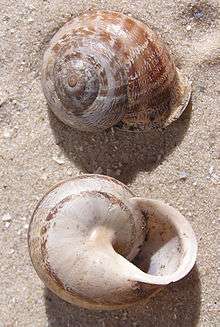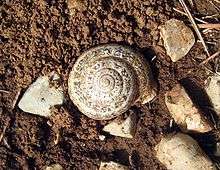Eobania vermiculata
| Eobania vermiculata | |
|---|---|
 | |
| Two shells of the species showing apical and apertural views | |
| | |
| An unusually dark, subadult live individual of Eobania vermiculata | |
| Scientific classification | |
| Kingdom: | Animalia |
| Phylum: | Mollusca |
| Class: | Gastropoda |
| (unranked): | clade Heterobranchia clade Euthyneura |
| Superfamily: | Helicoidea |
| Family: | Helicidae |
| Genus: | Eobania |
| Species: | E. vermiculata |
| Binomial name | |
| Eobania vermiculata (O. F. Müller, 1774)[1] | |
| Synonyms | |
|
Helix vermiculata O. F. Müller, 1774 | |
Eobania vermiculata also known as Helix vermiculata, common name the "chocolate-band snail" is a species of large, air-breathing, land snail, a terrestrial pulmonate gastropod mollusk in the family Helicidae, the true snails or typical snails.
Eobania vermiculata is the type species of the genus Eobania.
Distribution
This species of large land snail is common in the Mediterranean area; its distribution ranges from eastern Spain to the Crimea:
The nonindigenous distribution of Eobania vermiculata includes:
- This species has been introduced to southeastern Australia, where it is known as the chocolate-band snail.[4]
- One individual of this snail species was found living on a wall in Lewisham, London, England, in 2006.[5][6] It remains to be seen if a colony will establish itself or not.
- E. vermiculata has non-indigenous populations in Belgium, Germany, Hungary, the Netherlands, the USA, Australia, Japan, South Africa, Egypt, Israel, Saudi Arabia, Jordan, and Iran.[7]
This species is already established in the USA, and is considered to represent a potentially serious threat as a pest, an invasive species which could negatively affect agriculture, natural ecosystems, human health or commerce. Therefore, it has been suggested that this species be given top national quarantine significance in the USA.[8]
E. vermiculata is able to survive winters in the North-West European temperate zone, including Belgium and The Netherlands.[9]
Description
In this species the color of the shell is very variable. The background color can be whitish to greenish yellow, and the shell often has darker coloured bands or spots.[3] The ventral side of the shell frequently has two brown bands, and is whitish between the lowest band and the umbilicus.[3] The shell has 4-4.5 whorls.[3] The last whorl descends abruptly below the periphery of the shell.[3] The apertural margin is white, and is reflected (turned back)in adult shells, in juveniles this is true only on the columellar side.[3] The umbilicus is narrow and open in juveniles, only partly covered by the reflected columellar margin,; the umbilicus is however completely closed in adult shells.[3]
The width of the shell is 22–32 mm; the height of the shell is 14–24 mm.[3]
In northern Greece, the variability within the populations of this species seems to be lower than in southern Greece (Gávdos island: 24.5-33.5 mm in diameter of adult shells, average 28–29 mm, with no local variations in shell size).[3]
 Apical view of a shell of Eobania vermiculata |
Five views of a shell of Eobania vermiculata |
Five views of a cream-coloured shell of Eobania vermiculata |
Juveniles somewhat resemble the species Theba pisana (which also has a similar umbilicus); however Eobania vermiculata can be differentiated from that species by its much larger apex.[3]
Ecology
Eobania vermiculata live in a broad variety of habitats, usually in dry vegetation, mainly in coastal vicinity, also in agricultural crops.[3] It is very common in Crete, the species lives on practically every small island in the south Aegean.[3]
In northern Greece copulation takes place after the first rainfalls in autumn.[3] These snails create and use love darts as part of their mating behavior. Around 70 eggs per snail are laid 20 days later.[3] The size of the egg is 4.1 × 3 mm.[10] Juveniles hatch shortly after and grow about 12–13 mm in diameter per year for 2 years (growth is usually restricted to February to June in northern Greece, in Crete this period ends already in May).[3] Maturity is reached after 2 years when the diameter reaches 25 mm, the umbilicus becomes closed and the apertural margin becomes reflected.[3] Snails reach 29–30 mm diameter in May/June of the second year in northern Greece (in April in Crete), reaching a maximum diameter (33 mm) may take 5 years or more, but mortality increases greatly after 2 years.[3]
About 20% of the snails in a population survive to lay eggs in the 3rd year, 5% of the snails lay eggs again in the 4th year.[3] The mortality rates decrease with age.[3] The animals hibernate (in northern Greece) or aestivate (in Crete), but juveniles and adults show differences in their behaviour.[3] Adults dig into the soil and build an epiphragm, while juveniles search protected places under stones or leaves of low plants.[3]
Human use
The species is used for food. It is commercialized and exported from Greece to France, which led Lazaridou-Dimitriadou & Kattoulas (1981)[11] to propose restrictions on the size and seasons of collection for this species.[3]
References
This article incorporates public domain text from the reference.[3]
- ↑ Müller O. F. (1774). Vermivm terrestrium et fluviatilium, seu animalium infusoriorum, helminthicorum, et testaceorum, non-marinorum, succincta historia. Volumen alterum. pp. I-XXVI [= 1-36], 1-214, [1-10]. Havniae & Lipsiae. (Heineck & Faber).
- 1 2 Commonwealth of Australia. (April 2002). "Citrus Imports from the Arab Republic of Egypt. A Review Under Existing Import Conditions for Citrus from Israel". Agriculture, Fisheries and Forestry, Australia. Caption: Gastropods, page 12 and Appendix 2.
- 1 2 3 4 5 6 7 8 9 10 11 12 13 14 15 16 17 18 19 20 21 22 23 24 25 26 "Species summary for Eobania vermiculata". AnimalBase. Last modified 31 August 2010, accessed 13 October 2010.
- ↑ Eobania vemiculata. accessed 4 November 2008.
- ↑ Notton D. (2006). "Eobania vermiculata in the UK". Mollusc World 11: 6.
- ↑ JRS (December 2006). "Aliens: what can they teach us?". The Archeo+Malacology Group Newsletter (10): page 7.
- ↑ Ronsmans J. & Van den Neucker T. (2016). A persistent population of the chocolate-band snail Eobania vermiculata (Gastropoda: Helicidae) in Belgium. Belgian Journal of Zoology 146(1):66-68.
- ↑ Cowie R. H., Dillon R. T., Robinson D. G. & Smith J. W. (2009). "Alien non-marine snails and slugs of priority quarantine importance in the United States: A preliminary risk assessment". American Malacological Bulletin 27: 113-132. PDF.
- ↑ Ronsmans J. & Van den Neucker T. (2016). A persistent population of the chocolate-band snail Eobania vermiculata (Gastropoda: Helicidae) in Belgium. Belgian Journal of Zoology 146(1):66-68.
- ↑ Heller J. (2001). Life History Strategies. In: Barker G. M. (ed.) The biology of terrestrial molluscs. CABI Publishing, Oxon, UK, 2001, ISBN 0-85199-318-4. 1-146, cited page: 428.
- ↑ Lazaridou-Dimitriadou M. & Kattoulas M. (1981). "Contribution a l'étude de la biologie et de la croissance des escargots commercialisés en Grèce: Eobania vermiculata (Müller) et Helix aspersa Müller". Haliotis 11: 129-137.
External links
| Wikimedia Commons has media related to Eobania vermiculata. |
- "Eobania vermiculata". National Center for Biotechnology Information (NCBI).
- Ronsmans J. & Van den Neucker T. (2016). A persistent population of the chocolate-band snail Eobania vermiculata (Gastropoda: Helicidae) in Belgium. Belgian Journal of Zoology 146(1):66-68. PDF